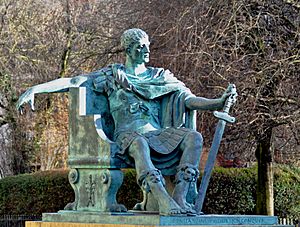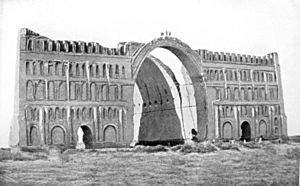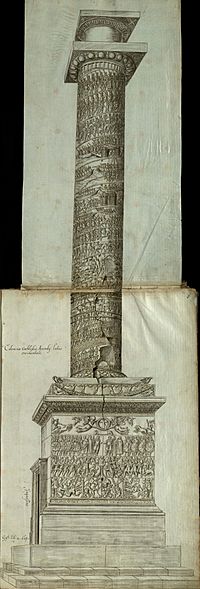Late antiquity facts for kids
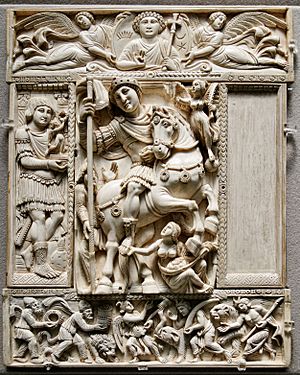
Late Antiquity is a special time in history. It's like a bridge connecting the ancient Roman and Greek world to the Middle Ages. This period usually spans from the 3rd to the 7th century AD, especially in Europe and around the Mediterranean Sea. A historian named Peter Brown helped make this term popular. He saw this time not as a decline, but as a lively period of new beginnings!
This era began after the Crisis of the Third Century (235–284 AD), a tough time for the Roman Empire. It ended with the rise of Islam and the early Muslim conquests (622–750 AD). In the western part of the Roman Empire, this period ended a bit earlier, around the 6th century, as the Early Middle Ages began.
The Roman Empire changed a lot during Late Antiquity. Emperor Diocletian started splitting the empire into Eastern and Western parts, often ruled by several emperors at once. The Sasanian Empire in Persia became a powerful rival, leading to many wars with Rome. The differences between the Greek East and Latin West also grew stronger.
Christianity became very important during this time. After some tough times, like the Diocletianic Persecution, Emperor Galerius allowed Christians to practice their faith. Then, Constantine the Great made Christianity legal in the empire. By the late 4th century, Emperor Theodosius I made Nicene Christianity the official religion of the Roman Empire.
The city of Constantinople became the main capital in the East by the 5th century. It grew bigger than Rome and became the largest city in the Mediterranean. Huge projects like the Valens Aqueduct, a 250 km long water system, were built to supply it.
Later, tribes like the Germanic, Hunnic, and Slavic peoples started moving into Roman lands. This led to events like the Visigoths sacking Rome in 410 AD and the Vandals sacking it in 455 AD. Eventually, the Western Roman Empire collapsed in 476 AD. New kingdoms, often ruled by Germanic tribes, took its place. The mix of Roman, Germanic, and Christian traditions created the basis for future European culture.
In the 6th century, the Eastern Roman Empire (also known as the Byzantine Empire) continued to thrive. Emperor Justinian the Great tried to bring back the old Roman Empire. His armies reconquered parts of Italy and North Africa. Justinian also built the magnificent Hagia Sophia, a stunning example of Byzantine architecture. Around this time, the first plague pandemic began, which had a big impact on the population. Meanwhile, the Sasanians in Persia built the impressive Taq Kasra, a huge archway that showed off their amazing architecture.
The middle of the 6th century saw some big challenges, including extreme weather and the terrible Plague of Justinian. In the 7th century, a long war between the Byzantines and Sasanians weakened both empires. This helped Islam emerge in the Arabian Peninsula with Muhammad. Arab armies then conquered vast territories, ending the Sasanian Empire and taking much of the Eastern Roman Empire's land. This period, with the rise of the Rashidun Caliphate and later the Umayyad Caliphate, generally marks the end of Late Antiquity.
Contents
Understanding the Term "Late Antiquity"
The term Spätantike (meaning "late antiquity" in German) became popular thanks to historians like Alois Riegl and Peter Brown. Peter Brown's book, The World of Late Antiquity (1971), changed how people saw this time. Instead of just a period of decline, he showed it as a vibrant era of new ideas and beginnings.
Some historians like to focus on how the later Roman Empire, especially after Emperor Diocletian's changes, smoothly transitioned into the Early Middle Ages. They emphasize that many medieval ideas, especially Christian ones, were already growing in the Roman Empire. Even some Germanic tribes, like the Ostrogoths and Visigoths, saw themselves as continuing Roman traditions.
The idea of "Late Antiquity" highlights that many social and cultural ways of life from Classical Antiquity continued. On the other hand, terms like "Early Middle Ages" or "Early Byzantine" suggest a sharper break from the classical past. The term "Migration Period" focuses on the movement of Germanic tribes, which led to new kingdoms in the former Western Roman Empire.
For a long time, the period after the fall of Rome was called the "Dark Ages." This was because there was a decline in population, knowledge, and living standards in Europe, and fewer historical records. However, this term is now mostly replaced by "Late Antiquity" because historians realize it was a time of significant change and new developments, not just darkness.
Religion in Late Antiquity
One of the biggest changes in Late Antiquity was the rise and growth of major religions like Christianity, Rabbinic Judaism, and eventually, Islam.
A huge moment for Christianity was when Emperor Constantine the Great (ruled 306–337 AD) converted in 312 AD. He made Christianity legal with the Edict of Milan in 313 AD. By the late 4th century, Emperor Theodosius the Great made Christianity the official state religion. This completely changed the old Roman world, which used to believe in many different gods.
Constantine I was very important for Christian history. He called the first big meeting of bishops at Nicaea in 325 AD. He also paid for the building of churches, like the Church of the Holy Sepulchre in Jerusalem.
Christian monasticism began in the deserts of Egypt in the 3rd century. Monks lived apart from society, focusing on prayer and simple living. This movement became very popular and influenced the Church greatly. Other unique Christian movements also appeared, like the Stylites, holy men who lived on top of tall poles for many years!
Late Antiquity also saw the decline of the traditional Roman state religion. Many new spiritual ideas and groups emerged, like Gnosticism and Neoplatonism.
Around this time, Mahāyāna Buddhism grew in India and along the Silk Road. Manichaeism, another faith, started in Mesopotamia and spread widely, even competing with Christianity for a while.
The invention of the parchment codex (a bound book, like modern books) was a big deal for these new religions. It was much easier to use and carry than the old papyrus scrolls. This helped spread religious texts and ideas quickly.
The Rise of Islam
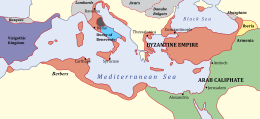
Islam appeared in the 7th century. Arab armies then invaded the Eastern Roman Empire and the Sassanian Empire of Persia, completely destroying the Persian Empire. They conquered all of North Africa and Visigothic Spain. The Islamic expansion into Europe was finally stopped by Charles Martel at the Battle of Tours in modern France.
Historians have different ideas about how Islam emerged. Some believe it was a completely new religion that came from outside the late antique world. This idea, called the "out of Arabia" thesis, suggests that the Arab invasions marked a sharp end to Late Antiquity and the beginning of the Middle Ages.
Other historians, like those who follow Peter Brown's ideas, see Islam as a product of the Late Antique world itself. They point out similarities between Islam and other religions and philosophies of the time, especially Christianity. For example, they note the importance of faith, holy people, and a single powerful God in Islam, similar to Christianity. They also highlight how early Islamic ideas seemed to respond to common religious and cultural issues of the late antique world. Close economic and military ties between Arabia, the Byzantine Empire, and the Sasanian Empire also suggest that Arabia was very much a part of the late antique world.
Political Changes
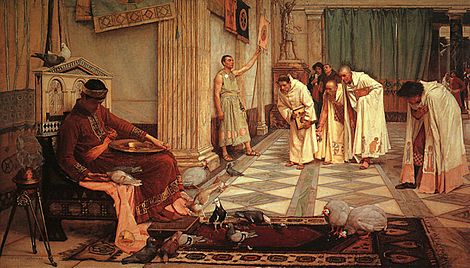
Late Antiquity brought big changes to how people lived and were governed in and around the Roman Empire.
In the 2nd and 3rd centuries, wealthy Roman citizens often held important local jobs. But as taxes increased and public events became very expensive, they found security by working for the distant Emperor. After Constantine moved the capital to Constantinople in 330 AD, the upper classes were divided. Some had connections to the emperor's government, while others, even if well-educated, found it harder to succeed. Success now meant navigating complex government channels. The simple toga of earlier Roman senators was replaced by fancy silk robes and jewelry, showing off their connection to the imperial court. The emperor's advisors were now called the consistorium, meaning those who "stood" in attendance, showing a more formal and distant relationship with the seated emperor.
Cities in Transformation
The Roman Empire was a network of cities. Archaeology helps us understand how these cities changed and sometimes collapsed. Two signs of this change were:
- Subdivision: Large public spaces and private homes were divided into smaller areas.
- Encroachment: Workshops and shops started to spill out into public streets, leading to market-like areas (like a souk).
Also, people started burying their dead inside city limits, which was against old Roman rules. This happened because people wanted to be buried near saintly shrines and relics. In Roman Britain, a layer of "dark earth" in cities suggests that people started gardening in former urban areas.
The population of Rome itself dropped dramatically, from 800,000 at the start of the period to just 30,000 by the end. This was partly due to the destruction of aqueducts during wars. A similar, though less severe, decline happened in Constantinople after the Plague of Justinian in 541 AD. Across Europe, urban populations generally decreased, and people returned to a more local economy, producing and consuming most things themselves, rather than relying on long-distance trade.
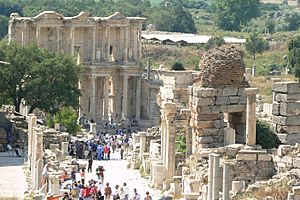
In the Eastern Roman Empire, cities like Constantinople continued to thrive for longer. However, Slavic invasions in the Balkans and Persian attacks in Anatolia eventually led to their decline in the 7th century. Cities in Syria, Jordan, and Palestine continued to function well into the 8th century.
In Greece, people in cities like Sparta and Corinth moved from their old city centers to fortified hills for safety. In Italy, people moved away from Roman roads, which were now seen as dangerous paths for invaders, and built new settlements on isolated, fortified hills.
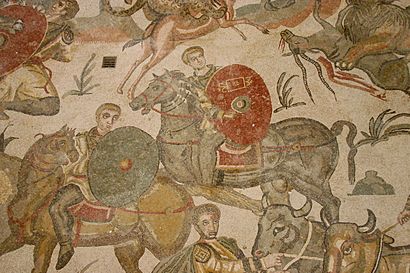
In the western Mediterranean, very few new cities were founded between the 5th and 8th centuries. The Visigoths founded a few "victory cities" for military reasons. The arrival of the highly urbanized Islamic culture after 711 AD helped many cities in Spain survive into the Middle Ages.
In Gaul (modern France), cities shrank and built strong defenses around their central areas. In Britain, urban life collapsed very quickly in the 5th and 6th centuries, even before the Romans left. This suggests that Roman towns in Britain were perhaps more for military and administrative needs than for strong local economies.
Classical Antiquity was an age of cities, where citizens governed themselves. But as the Roman Empire grew, local power faded. By the Crisis of the Third Century, serving in local government became a burden. People fled to wealthy estates to escape taxes, military service, famine, and disease. Many cities destroyed by wars couldn't be rebuilt. Plagues and famines hit city dwellers hard, especially those who knew how to keep public services running. The extreme weather events of 535–536 and the Plague of Justinian further devastated cities, as trade networks helped the plague spread. The end of the polis (city-state) model and the general decline of cities is a key feature of Late Antiquity.
Public Buildings
In cities, the Roman Empire's stretched economy meant less growth. Almost all new public buildings in Late Antiquity were built by emperors or imperial officials. Efforts were made to maintain existing structures. For example, free grain and oil were still given to many people in Rome until the late 5th century.
The basilica, which was a law court or a place for imperial receptions, became the main public building in the 4th century. Because cities had less money, they spent it on walls, baths, and markets. They spent less on theaters, libraries, and other public entertainment places. As Christianity grew, many buildings linked to pagan religions were neglected. Instead, money was spent on building churches and helping the poor. Christian basilicas were designed like the old civic ones, but the bishop took the place of the magistrate, representing Christ Pantocrator. Justinian's Hagia Sophia in Constantinople was an amazing display of power and architecture. In the former Western Roman Empire, almost no large buildings were constructed after the 5th century.
City life in the East was hit hard by the plague in the 6th and 7th centuries, and then by Slavic invasions and Persian destruction. However, cities in Syria, Jordan, and Palestine continued to thrive into the 8th century.
Sculpture and Art
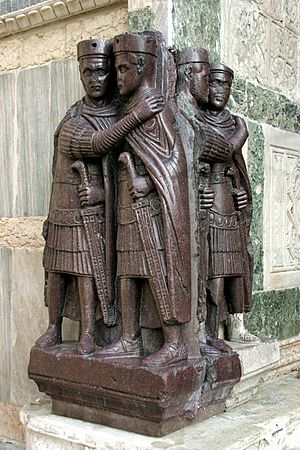
The art of Late Antiquity shows the shift from classical Roman art to the beginnings of medieval art. This period saw a change from the realistic and idealized art of ancient Greece and Rome to a more symbolic and stylized art. Unlike classical art, Late Antique art didn't focus on the beauty of the human body. Instead, it hinted at a deeper, spiritual meaning. Also, as Christianity grew and the Western Roman Empire declined, painting and freestanding sculptures became less popular. Mosaics, architecture, and relief sculptures became more important.
As emperors from the provinces came to power in the 3rd century, they brought new artistic styles. For example, artists started showing human bodies in a more rigid and frontal way, rather than realistically. You can see this clearly in the Portrait of the Four Tetrarchs statue in Venice. These figures are short and blocky, holding swords, and they lack individual features. The Arch of Constantine in Rome, which mixes old and new styles, clearly shows this change. Art became simpler, and natural designs became more abstract. Also, the size of figures often showed their importance (hierarchy of scale) rather than using realistic perspective.
Around 300 AD, Early Christian art began to create new public forms, including sculpture, which Christians had previously avoided. Sarcophagi (stone coffins) became very detailed, showing many different scenes.
Many of these new, more abstract styles can be seen in the sparkling mosaics of the era. Mosaics moved from being floor decorations to a major way of creating religious art in churches. The shiny surfaces of the mosaic pieces (tesserae) glittered in the light, bringing the churches to life. Unlike older paintings, mosaics focused more on showing a symbolic truth than a realistic scene. As Late Antiquity continued, art became more focused on biblical themes and was influenced by Christianity's interaction with the Roman state.
Even the way Jesus Christ was shown changed. He was often shown as a traveling philosopher or a "Good Shepherd." But increasingly, he was shown with the status of a Roman emperor, wearing purple robes and holding an orb and scepter. This new image might have come from the way Jupiter or classical philosophers were depicted.
Luxury arts also flourished. Beautifully illustrated manuscripts on vellum and parchment appeared from the 5th century, including copies of Roman classics and, more and more, Christian texts. Carved diptychs (two-paneled artworks) were used for both everyday subjects and religious ones. Rich collections of silver items, like the Mildenhall Treasure and Hoxne Hoard, were also common from the 4th century.
Literature
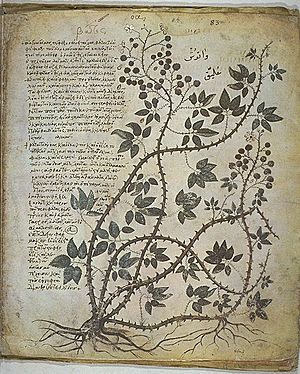
In literature, Late Antiquity saw a decline in the use of classical Greek and Latin. Instead, new literary cultures grew in languages like Syriac, Armenian, Georgian, Ethiopic, Arabic, and Coptic.
Literary style also changed. Writers preferred encyclopedic works that summarized earlier writings, often using complex allegories (stories with hidden meanings). Famous examples include The Marriage of Mercury and Philology by Martianus Capella and The Consolation of Philosophy by Boethius. These books later became very important for education in the Middle Ages.
The 4th and 5th centuries also saw a huge amount of Christian literature being written. Famous Greek writers included Eusebius of Caesarea and John Chrysostom. Important Latin writers included Ambrose of Milan, Jerome, and Augustine of Hippo. However, some authors like Ammianus Marcellinus (4th century) and Procopius of Caesarea (6th century) kept the tradition of classical Greek history writing alive in the Byzantine Empire.
Poetry
Some notable poets from this period include:
- Greek poets: Quintus Smyrnaeus, Nonnus, and Romanus the Melodist.
- Latin poets: Ausonius, Claudian, and Sidonius Apollinaris.
- Jewish poets: Yannai and Eleazar ben Killir.
Timeline of Key Events
- 284 AD: Diocletian becomes emperor, ending a tough period for Rome.
- 285 AD: Emperor Diocletian splits the Roman Empire into Eastern and Western parts.
- 311 AD: Emperor Galerius allows Christians to practice their religion freely.
- 313 AD: Constantine I and Licinius issue the Edict of Milan, making Christianity legal.
- 325 AD: The First Council of Nicaea is held by Constantine I.
- 330 AD: Constantinople is officially dedicated as the new capital.
- 376 AD: The Thervingi (a Gothic tribe) are allowed to cross the Danube River into Roman territory.
- 378 AD: At the Battle of Adrianople, Eastern Roman Emperor Valens is defeated and killed by Gothic rebels.
- 380 AD: Theodosius I makes Nicene Christianity the official state religion of the Roman Empire.
- 395 AD: Theodosius I outlaws all pagan religions.
- 406 AD: Various Germanic tribes cross the Rhine River, a major turning point.
- 410 AD: Alaric I and the Visigoths sack Rome. Roman rule ends in Britain.
- 413 AD: The strong Theodosian Walls around Constantinople are completed.
- 432 AD: Saint Patrick begins converting Ireland to Christianity.
- 451 AD: The Battle of the Catalaunian Plains is fought between the Huns and a Roman-Visigothic alliance.
- 455 AD: The Vandals under Genseric sack Rome.
- 476 AD: Romulus Augustus, the last Western Roman Emperor, is forced to step down. This is often seen as the end of the Western Roman Empire and Classical Antiquity.
- 529 AD: Emperor Justinian I orders the closing of ancient philosophical schools in the Eastern Roman Empire, including the famous Academy in Athens.
- 533-534 AD: The Eastern Roman General Belisarius reconquers North Africa from the Vandal Kingdom.
- 534 AD: The Corpus Juris Civilis, also known as the Code of Justinian, is completed. This new law code greatly influenced later European law.
- 535-536 AD: Extreme weather events, possibly caused by a volcanic eruption, lead to a "volcanic winter" and widespread famine.
- 537 AD: The Hagia Sophia, a massive Christian church, is built in Constantinople.
- 542 AD: The Plague of Justinian arrives in Constantinople and spreads across the Mediterranean, starting a long pandemic.
- 602 AD: The final, exhausting Byzantine-Sasanian War begins.
- 622 AD: The Hijrah: Muhammad and Abu Bakr flee Mecca for Medina, marking the beginning of the Islamic community.
- 626 AD: Avar, Slav, and Sasanian forces besiege Constantinople.
- 636 AD: The Battle of the Yarmuk: Arab forces conquer the Levant (modern Syria, Jordan, Palestine).
- 640 AD: Arab general Amr ibn al-A'as begins the Muslim conquest of Egypt.
- 651 AD: The Muslim conquest of Persia leads to the Fall of the Sasanian Empire.
- 698 AD: Roman Carthage is destroyed by Arab forces, ending the Exarchate of Africa.
Images for kids
-
Late 4th-century Roman bust of a Germanic slave in Trier, Germany.
See also
 In Spanish: Antigüedad tardía para niños
In Spanish: Antigüedad tardía para niños


